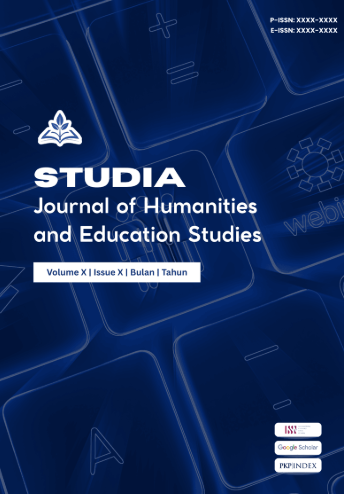Development of a Biotechnology Innovation Handout Based on Research on the Ratio of Butterfly Pea Flower (Clitoria ternatea L.) Tea, Aquafaba, and Fermentation Duration on Lactic Acid Levels in Calpis Beverages for Grade XII High School Biology Learning
Keywords:
Aquafaba, Biotechnology innovation, Butterfly pea flower, Handout development, Lactic acidAbstract
This study aimed to develop a biotechnology innovation handout for Grade XII biology learning, based on experimental research investigating the effects of butterfly pea flower (Clitoria ternatea L.) tea ratio, aquafaba addition, and fermentation duration on lactic acid levels in Calpis-like beverages. The research employed an experimental design using factorial treatments with varying tea–aquafaba ratios (1:0 to 3:1) and fermentation times (0, 24, 48, and 72 hours), inoculated with Lactobacillus acidophilus FNCC 0051. Lactic acid levels were measured by titration, supported by pH observations, color changes, and sensory evaluations. Results showed that lactic acid concentration increased from 0.00150% at 0 hours to a peak of 0.00240% at 48 hours, before declining at 72 hours. The 1:1 tea aquafaba ratio produced the most balanced acidity, stable color, and favorable sensory properties. These findings were then integrated into a handout designed according to the 5E instructional model. Expert validation rated the handout “very feasible” with an overall score of 89.5%. The study concludes that research-based handouts can effectively contextualize biotechnology, improve student engagement, and foster scientific literacy while promoting local food innovation.
Downloads
References
Bybee, R. W. (2014). Model instruksional BSCS 5E: Menciptakan momen belajar. Arlington, VA: NSTA Press.
Derryana, M. (2022). Pengembangan media pembelajaran bioteknologi berbasis fermentasi. Jurnal Pendidikan Biologi, 14(2), 55–63.
Horiuchi, H., & Sasaki, K. (2018). Minuman susu fermentasi “Calpis” dan manfaat kesehatannya. Journal of Dairy Science, 101(5), 3778–3785. https://doi.org/10.3168/jds.2017-13711
Hutkins, R. W. (2019). Mikrobiologi dan teknologi pangan fermentasi (Edisi ke-2). Hoboken, NJ: Wiley-Blackwell.
Khoo, H. E., Azlan, A., Tang, S. T., & Lim, S. M. (2017). Antosianidin dan antosianin: Pigmen alami sebagai bahan pangan, farmasi, dan manfaat kesehatan potensial. Food & Nutrition Research, 61(1), 1361779. https://doi.org/10.1080/16546628.2017.1361779
Marco, M. L., Sanders, M. E., Gänzle, M., Arrieta, M. C., Cotter, P. D., De Vuyst, L., ... & Hutkins, R. (2017). Pernyataan konsensus Asosiasi Ilmiah Internasional untuk Probiotik dan Prebiotik tentang pangan fermentasi. Nature Reviews Gastroenterology & Hepatology, 14(4), 196–208. https://doi.org/10.1038/nrgastro.2016.161
Mukherjee, P. K., Kumar, V., Kumar, N. S., & Heinrich, M. (2008). Obat Ayurveda Clitoria ternatea—Dari penggunaan tradisional ke penilaian ilmiah. Journal of Ethnopharmacology, 120(3), 291–301. https://doi.org/10.1016/j.jep.2008.09.009
Mustafa, R., He, Y., Shim, Y. Y., & Reaney, M. J. T. (2018). Aquafaba, bahan tambahan reologi nabati baru: Penemuan dan aplikasinya. Trends in Food Science & Technology, 74, 193–201. https://doi.org/10.1016/j.tifs.2018.02.025
Nielsen, S. S. (2017). Manual laboratorium analisis pangan (Edisi ke-4). Cham, Swiss: Springer. https://doi.org/10.1007/978-3-319-44127-6
Rahayu, E. S., Kusnadi, J., & Fitri, L. (2020). Pengaruh lama fermentasi terhadap produksi asam laktat pada minuman probiotik. Indonesian Journal of Food Science, 7(1), 15–23.
Sampson, V., & Schleigh, S. (2016). Argumentasi ilmiah dalam biologi: 30 aktivitas kelas. Arlington, VA: NSTA Press.
Sari, N., & Utami, R. (2019). Sumber daya tanaman lokal untuk inovasi pangan fungsional. Indonesian Journal of Agricultural Research, 22(2), 75–82.
Sigurdson, G. T., Tang, P., & Giusti, M. M. (2017). Pewarna alami: Sifat dan stabilitas antosianin. Annual Review of Food Science and Technology, 8, 261–280. https://doi.org/10.1146/annurev-food-030216-030046
Tamime, A. Y., & Robinson, R. K. (2007). Yoghurt: Ilmu dan teknologi (Edisi ke-3). Cambridge, UK: Woodhead Publishing.
Wahyuningsih, S., Wulandari, D., & Fibriana, F. (2021). Penambahan ekstrak bunga telang pada yogurt meningkatkan aktivitas antioksidan. Journal of Food Science and Nutrition, 9(2), 87–94.
Yadav, A., Subedi, D., & Shrestha, P. (2021). Pengajaran bioteknologi melalui instruksi kontekstual: Dampaknya pada pembelajaran siswa. International Journal of Biology Education, 10(3), 45–53.
Downloads
Published
Issue
Section
License
Copyright (c) 2025 Febriyana Dwimas Praarafati (Author)

This work is licensed under a Creative Commons Attribution-ShareAlike 4.0 International License.













